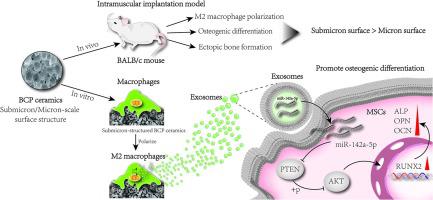当前位置:
X-MOL 学术
›
Mater. Des.
›
论文详情
Our official English website, www.x-mol.net, welcomes your feedback! (Note: you will need to create a separate account there.)
Calcium phosphate ceramic-induced osteoimmunomodulation: Submicron-surface-treated macrophage-derived exosomes driving osteogenesis
Materials & Design ( IF 8.4 ) Pub Date : 2024-03-31 , DOI: 10.1016/j.matdes.2024.112903 Fuying Chen , Xiangfeng Li , Yumei Xiao , Xiangdong Zhu , Xuening Chen , Xingdong Zhang
Materials & Design ( IF 8.4 ) Pub Date : 2024-03-31 , DOI: 10.1016/j.matdes.2024.112903 Fuying Chen , Xiangfeng Li , Yumei Xiao , Xiangdong Zhu , Xuening Chen , Xingdong Zhang

|
The development of osteoimmunology has highlighted the crucial role of biomaterial surface topography in modulating macrophage responses, subsequently affecting bone formation. However, the underlying mechanism remains largely unexplored. This study introduced two biphasic calcium phosphate (BCP) ceramics with different surface architecture, finding that compared to micron-scale counterparts (BCP2, ∼3.07 μm), BCP with submicron-scale structure (BCP1, ∼0.66 μm) enhanced ectopic bone formation and facilitated M2 macrophage polarization . Previous studies have focused predominantly on soluble cytokines secreted by macrophages, the significance of exosomes in intercellular communication has been overlooked. This study isolated exosomes from macrophages treated with either submicron- or micron-scale surfaces, designated as B1-Exos and B2-Exos, respectively. Notably, B1-Exos could significantly improve osteogenic differentiation of mesenchymal stem cells (MSCs), potentially attributable to miRNA cargos within these exosomes. SmallRNA sequencing, western blotting, qRT-PCR, and bioinformatics analyses indicated that submicron-sized BCP1 ceramic markedly elevated miR-142a-5p levels in macrophage-derived exosomes, activating the PTEN/AKT signaling pathway, and consequently guiding the differentiation of MSCs towards osteoblast lineage. These findings not only deepen our understanding of the biomaterial-mediated osteoinduction mechanism, but also inform the design of bone repair materials with specialized surface design for proper immunomodulation to initiate osteogenesis.
中文翻译:

磷酸钙陶瓷诱导的骨免疫调节:亚微米表面处理的巨噬细胞衍生的外泌体驱动成骨
骨免疫学的发展凸显了生物材料表面形貌在调节巨噬细胞反应进而影响骨形成中的关键作用。然而,其根本机制在很大程度上仍未被探索。本研究介绍了两种具有不同表面结构的双相磷酸钙(BCP)陶瓷,发现与微米级对应物(BCP2,∼3.07 μm)相比,具有亚微米级结构(BCP1,∼0.66 μm)的BCP增强了异位骨形成和促进M2巨噬细胞极化。以往的研究主要集中在巨噬细胞分泌的可溶性细胞因子上,而忽略了外泌体在细胞间通讯中的重要性。这项研究从用亚微米或微米级表面处理的巨噬细胞中分离出外泌体,分别命名为 B1-Exos 和 B2-Exos。值得注意的是,B1-Exos 可以显着改善间充质干细胞 (MSC) 的成骨分化,这可能归因于这些外泌体中的 miRNA 货物。 SmallRNA测序、蛋白质印迹、qRT-PCR和生物信息学分析表明,亚微米尺寸的BCP1陶瓷显着提高了巨噬细胞来源的外泌体中的miR-142a-5p水平,激活了PTEN/AKT信号通路,从而引导MSC向分化方向分化。成骨细胞谱系。这些发现不仅加深了我们对生物材料介导的骨诱导机制的理解,而且还为具有专门表面设计的骨修复材料的设计提供了信息,以进行适当的免疫调节以启动成骨。
更新日期:2024-03-31
中文翻译:

磷酸钙陶瓷诱导的骨免疫调节:亚微米表面处理的巨噬细胞衍生的外泌体驱动成骨
骨免疫学的发展凸显了生物材料表面形貌在调节巨噬细胞反应进而影响骨形成中的关键作用。然而,其根本机制在很大程度上仍未被探索。本研究介绍了两种具有不同表面结构的双相磷酸钙(BCP)陶瓷,发现与微米级对应物(BCP2,∼3.07 μm)相比,具有亚微米级结构(BCP1,∼0.66 μm)的BCP增强了异位骨形成和促进M2巨噬细胞极化。以往的研究主要集中在巨噬细胞分泌的可溶性细胞因子上,而忽略了外泌体在细胞间通讯中的重要性。这项研究从用亚微米或微米级表面处理的巨噬细胞中分离出外泌体,分别命名为 B1-Exos 和 B2-Exos。值得注意的是,B1-Exos 可以显着改善间充质干细胞 (MSC) 的成骨分化,这可能归因于这些外泌体中的 miRNA 货物。 SmallRNA测序、蛋白质印迹、qRT-PCR和生物信息学分析表明,亚微米尺寸的BCP1陶瓷显着提高了巨噬细胞来源的外泌体中的miR-142a-5p水平,激活了PTEN/AKT信号通路,从而引导MSC向分化方向分化。成骨细胞谱系。这些发现不仅加深了我们对生物材料介导的骨诱导机制的理解,而且还为具有专门表面设计的骨修复材料的设计提供了信息,以进行适当的免疫调节以启动成骨。



























 京公网安备 11010802027423号
京公网安备 11010802027423号